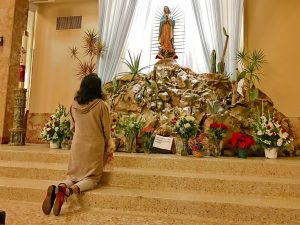MẸ ĐẦY ƠN PHƯỚC, CẦU CHO CHÚNG CON.
Đức Me Guadalupe được tôn vinh là Đúc Mẹ của lục địa Bắc và Nam Châu Mỹ.
@Iphone7, SN
MARIAN APPARITION HISTORY~~~~~~~~~~~~~~~~~~~~~~~~~~~~~~~~~~~~~~~~~~~~~~~~~~~~~~~~~~
Official Catholic accounts state that the Virgin Mary appeared four times before Juan Diego and one more before Juan Diego's uncle. According to these accounts the first apparition occurred on the morning of December 9, 1531, when a native Mexican peasant named Juan Diego saw a vision of a maiden at a place called the Hill of Tepeyac, which would become part of Villa de Guadalupe, a suburb of Mexico City. Speaking to Juan Diego in his native Nahuatl language (the language of the Aztec empire), the maiden identified herself as the Virgin Mary, "mother of the very true deity and asked for a church to be built at that site in her honor.
Based on her words, Juan Diego then sought out the archbishop of Mexico City, Fray Juan de Zumárraga, to tell him what had happened. As the bishop did not believe Diego, on the same day, Juan Diego saw the Virgin Mary for a second time (the second apparition); she asked him to keep insisting.
On Sunday, December 10, Juan Diego talked to archbishop for a second time. The latter instructed him to return to Tepeyac Hill, and ask the lady for a miraculous sign to prove her identity. That same day the third apparition occurred when Diego returned to Tepeyac and, encountering the Virgin Mary reported the bishop's request for a sign; she consented to provide one on the following day (December 11).
By Monday, December 11, however, Juan Diego's uncle Juan Bernardino had fallen sick and Juan Diego was obliged to attend to him. In the very early hours of Tuesday, December 12, Juan Bernardino's condition having deteriorated overnight, Juan Diego set out to Tlatelolco to fetch a priest to hear Juan Bernardino's confession and minister to him on his death-bed.
In order to avoid being delayed by the Virgin and ashamed at having failed to meet her on the Monday as agreed, Juan Diego chose another route around the hill, but the Virgin intercepted him and asked where he was going (fourth apparition); Juan Diego explained what had happened and the Virgin gently chided him for not having had recourse to her. In the words which have become the most famous phrase of the Guadalupe event and are inscribed over the main entrance to the Basilica of Guadalupe, she asked: "No estoy yo aqui que soy tu madre?" (Am I not here, I who am your mother?). She assured him that Juan Bernardino had now recovered and she told him to gather flowers from the top of Tepeyac Hill, which was normally barren, especially in December. Juan followed her instructions and he found Castilian roses, not native to Mexico, blooming there. The Virgin arranged the flowers in Juan's tilma, or cloak, and when Juan Diego opened his cloak before archbishop Zumárraga on December 12, the flowers fell to the floor, and on the fabric was the image of the Virgin of Guadalupe.
The next day, on December 13, Juan Diego found his uncle fully recovered, as the Virgin had assured him, and Juan Bernardino recounted that he too had seen her, at his bed-side (fifth apparition); that she had instructed him to inform the bishop of this apparition and of his miraculous cure; and that she had told him she desired to be known under the title of Guadalupe.
The bishop kept Juan Diego's mantle first in his private chapel and then in the church on public display where it attracted great attention. On December 26, 1531 a procession formed for taking the miraculous image back to Tepeyac where it was installed in a small hastily erected chapel. In course of this procession, the first miracle was allegedly performed when an Indian was mortally wounded in the neck by an arrow shot by accident during some stylized martial displays executed in honour of the Virgin. In great distress, the Indians carried him before the Virgin's image and pleaded for his life. Upon the arrow being withdrawn, the victim made a full and immediate recovery.[7]
Juan Diego's tilma has become Mexico's most popular religious and cultural symbol, and has received widespread ecclesiastical and popular support. In the 19th century it became the rallying call of American-born Spaniards in New Spain, who saw the story of the apparition as legitimizing their own Mexican origin and infusing it with an almost messianic sense of mission and identity – thus also legitimizing their armed rebellion against Spain.
Historically the devotion to Our Lady of Guadalupe did not lack clerical opponents within Mexico, especially in the early years, and in more recent times some Catholic scholars, and even a former abbot of the basilica, Monsignor Guillermo Schulenburg, have openly doubted the historical existence of Juan Diego, referring to the devotion as merely symbolic, propagated by a sensational cult. Nonetheless, Juan Diego was canonized in 2002, under the name Saint Juan Diego Cuauhtlatoatzin.
While the image garners much religious devotion and Mexican patriotism, scholarly criticism on the image is also notable, considering the artistic disproportion of the image, the similarity of the image to Spanish pre-colonial artwork closely related to the Aztec colony at the time, the alleged relationship of Marcos Cipac de Aquino in either inventing or amending the tilma cloak, and the public declaration of the abbot of the Guadalupe shrine pertaining to the false existence of the Marian apparitions.

